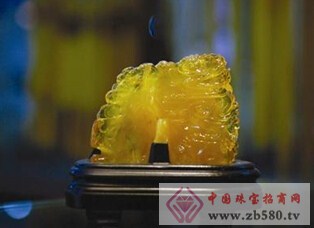Too many imitations, how to identify amber?
Today, amber imitations on the market are endless, and rosins, plastics, and resins are common imitation materials. Imitations not only fail to meet the standard aesthetics, but also have no collection value. How should consumers identify amber?

Difference from similar resins
The most similar resins to amber are hard resins and rosins.
1. Hard resin is a semi-fossil resin with a very new geological age. It has a similar composition to amber. It is dripped on the surface of the hard resin with a small drop of ether. The hard resin will soften and stick, and the amber will not change. .
2. Rosin is a non-geological resin, which is light yellow, opaque, light in weight and very low in hardness. It can be kneaded into powder by hand. There are many oil droplets on the surface, and the surface of the lake is smooth and translucent. The inclusions are more common, and the animal and plant inclusions and texture inside the amber can be seen with the naked eye.
The difference between reconstituted amber
Some small pieces of lake debris that cannot be directly used to make jewelry are sintered at a suitable temperature and pressure to form a large amber, called reconstituted amber. The color of the reconstituted amber is pure, the transparency is high, the surface is not smooth, and the magnified structure has a granular structure, a syrup-like agitating structure, and sometimes contains an unmelted material; while the natural amber surface is smooth, contains bubbles, and is mostly round, and usually has Animal and plant debris.
Difference from imitation
The imitation of amber is plastic, glass and chalcedony:
1. Plastic plastics are very similar to amber in color, warmth and electrical properties, but the density is very different from amber.
In addition to polystyrene floating in saturated brine, all of the plastic sinks because they are denser than saturated brine (1.2) and amber has a density of 1.08 so they can float in saturated brine.
The outer plastic is cuttable, and when the knife is cut on one side of the sample, it peels off, and the lake has a small shell-like gap due to its brittleness.
With hot acupuncture, the plastic will have a variety of odors, while amber can give off the smell of rosin.
2. Glass and chalcedony can imitate amber in color, but its nature is very different from amber. Their specific gravity is much heavier than amber, and they all have a cool feeling. They can be distinguished by hand rubbing. In addition, Both the glass and the chalcedony are hot acupuncture.
Embroidery is a general term for various decorative patterns embroidered on fabrics by needle and thread. Embroidery is divided into silk embroidery and feather embroidery. It is a kind of decorative fabric that uses a needle to puncture silk thread or other fibers and yarns with certain patterns and colors on the embroidered materials, and then forms the decorative pattern with the embroidery trace. It is the art of adding human design and production to any fabric that exists with needles and threads. Embroidery is one of the traditional Chinese folk crafts, which has a history of at least two or three thousand years in China. Chinese embroidery mainly includes Suzhou embroidery, Hunan embroidery, Shu embroidery and Guangdong embroidery. Embroidery techniques include: wrong needle embroidery, random needle embroidery, net embroidery, all over embroidery, lock silk, nasi, Najin, Pingjin, Yingjin, Panjin, fluting, scraping, poking, sprinkling, cross stitch, etc. the main uses of embroidery include life and art decoration, such as clothing, bedding, tablecloth, stage, art decoration.
Arts Patches Embroidery,Custom Embroidery Patch,Embroidery Sequin Patch,Embroidered Tulle Fabric
Shenzhen Longxiang embroidery products Co., Ltd , https://www.lxembroidery.com